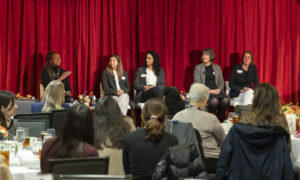With Los Angeles County’s population in decline, one might expect even just a little relief for the region’s costly housing market, where demand outstrips supply.
Yet as the county’s population fell by more than 500,000 over the past decade, the number of households actually grew due largely to more single residences, especially in the City of Los Angeles. Meanwhile, the share of households with children fell below the national average.
That’s according to the inaugural State of Los Angeles County Housing and Neighborhoods (SOLACHAN) report from the USC Lusk Center for Real Estate.
That seeming paradox of declining population yet sustained housing demand is among the notable findings from the SOLACHAN report, a data-driven examination of L.A. County’s housing and demographic landscape.

Master of Real Estate Development
From Vision to Reality
Master the art of real estate development and elevate your career.
Find Out MoreAnother surprising finding was that homeownership rates fell the fastest among two middle income groups – those making between $50,000 and $149,000 per year – noted Richard Green, Director of the USC Lusk Center, a research center affiliated with the USC Price School of Public Policy. Green pointed out that homeownership provides wealth generation and life stability, making it important for equity and social reasons.
“My biggest takeaway is that even the middle class – even what one might call the upper middle class here in Los Angeles – is seeing their home ownership opportunities fall. And I think we need to worry about that,” Green said during introductory remarks at a presentation of the findings on Aug. 18.
The new annual analysis comes during an especially challenging time for housing. The Los Angeles region is slowly recovering from the devastating wildfires in January. Meanwhile, the Section 8 federal housing program will be cut.
Developed by USC Lusk’s Neighborhood Data for Social Change (NDSC) program, the report identifies and quantifies the challenges and recent shifts shaping the region’s housing crisis. The report was also supported by LABarometer, a research center housed at the USC Dornsife Center for Economic and Social Research; and the USC Homelessness Policy Research Institute,

Master of Urban Planning
Make Cities More Just, Livable & Sustainable
USC’s MUP degree trains students to improve the quality of life for urban residents and their communities worldwide.
Find Out More“This report’s purpose is to empower L.A. County with clear, actionable data to inform decisions and foster accountability,” said Caroline Bhalla, Director of Civic Engagement for USC Lusk. “Each chapter offers a data-driven historical view of how today’s housing challenges took shape, providing essential context for the choices ahead.”
Findings from the report include:
- Housing production in L.A. County has declined sharply over the decades, from more than 70,000 units annually in the 1950s to less than 15,000 per year in the 2010s.
- Between 2018 and 2024, just under 152,000 new units were certified, mostly rentals, with only 10% affordable by lower-income households.
- Homeownership in the county has declined to 45%, the lowest level in more than 50 years. Homeownership among Black households declined more than any other racial or ethnic group — a trend not mirrored at the state or national level.
- More than 90% of renter households earning less than $50,000 spend more than 30% of their income on rent and utilities.
- The vast majority of unhoused Angelenos lived in the county before losing their homes, emphasizing the link between local housing affordability and homelessness.
Researchers revealed their findings during a launch event for the report hosted by USC Lusk. Following a presentation of the report’s findings, the event featured discussions on the future of housing production and Black homeownership in L.A. County, including speakers from universities, housing agencies, lenders and other stakeholders.
It wasn’t all bad news. Using data from the most recent Los Angeles Homeless Count, the report noted that the estimated homeless population fell 5% in 2025 to 67,777 – the first significant drop in years. The reversal was likely due to increased shelter availability and encampment resolution efforts, the report noted.
“Problems that take decades to create also take a long time – not decades but certainly a whole decade – to start to address,” said Randall Kuhn, a Professor of Community Health Sciences from the University of California, Los Angeles, who presented the report’s homelessness findings. “We’ve started to bend the curve.”





